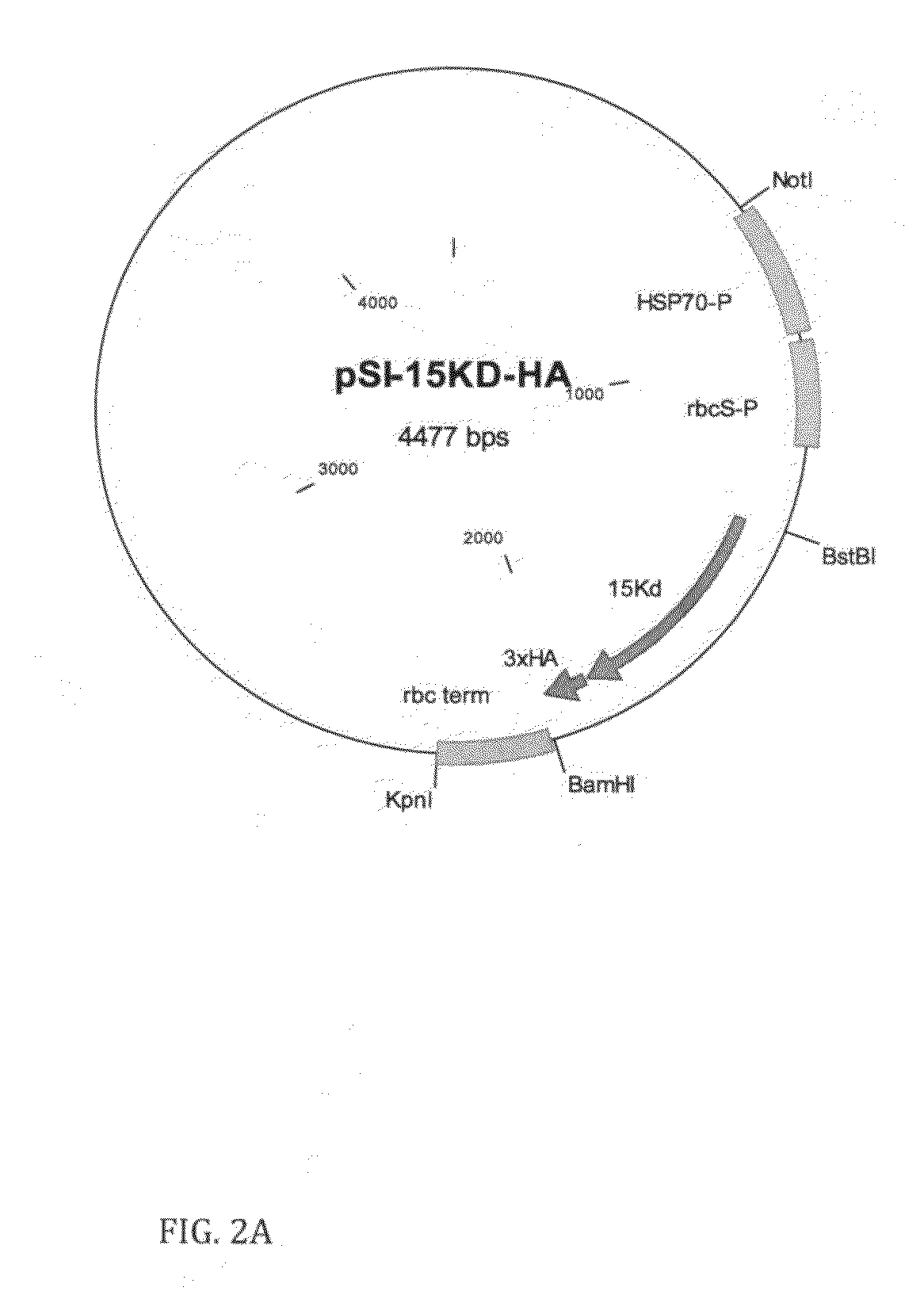Content of the essential amino acids lysine and methionine in algae and cyanobacteria for improved animal feed
a technology of amino acids and amino acids, applied in the field of genetically engineering algae and cyanobacteria, can solve the problems of ineffective aquaculture, insufficient components specific to fishmeal, future growth of aquaculture production, etc., and achieve the effect of improving the content of essential amino acids, improving the nutritional quality of alga/cyanobacteria, and satisfying the growing needs of fishmeal
- Summary
- Abstract
- Description
- Claims
- Application Information
AI Technical Summary
Benefits of technology
Problems solved by technology
Method used
Image
Examples
example 1
Expression of Mutated Form of Cystathionine γ-Synthase (CGS) (SEQ ID NO: 15), Together with Zea mays Delta Zein 15 Kd Protein Alone (SEQ ID NO: 16) or Fused to Zea mays Delta Zein 10 kD Protein (SEQ ID NO: 17)
[0042]The D-AtCGS coding sequence (Hacham et al., 2006), fused to Chlamydomonas rbcS chloroplast transit peptide (SEQ ID NO: 13) and 3xHA epitope tag, was chemically synthesized according to Chlamydomonas codon usage (SEQ ID NO: 14) and cloned downstream to the Chlamydomonas HSP70-rbcS fusion promoter and upstream to rbcS terminator in the plasmid pSI103 (Sizova et al., 2001) replacing the aphVIII gene (FIG. 1).
[0043]The Zea mays delta zein 15 Kd gene alone (SEQ ID NO: 16) and fused to Zea mays delta zein 10 Kd using the hinge region of anti HSV antibody (accession number: AY191459) as a linker, was synthesized de novo according to Chlamydomonas codon usage (SEQ ID NO: 17). This HSV antibody was previously expressed in Chlamydomonas chloroplasts as was shown by Mayfield et al. ...
example 2
Expression of Zea mays Delta Zein 15 kD Protein Alone (SEQ ID NO: 18) or Fused to Zea mays Delta Zein 10 kD Protein (SEQ ID NO: 19) in Chlamydomonas Chloroplasts, Together with Mutated Form of Cystathionine γ-Synthase (CGS) (SEQ ID NO: 15).
[0051]The coding sequence of Zea mays delta zein 151(13-HA alone (SEQ ID NO: 18) or fused to Zea mays delta zein 10 kD using the hinge region of anti HSV antibody (accession number: AY191459) as a linker are de novo synthesized according to Chlamydomonas chloroplast codon usage. This HSV antibody was previously expressed in Chlamydomonas chloroplasts as was shown in Mayfield et al. (2003). The coding sequences are cloned under the control of atpA promoter and rbcL terminator (SEQ ID NO: 10) in plasmid p423 (Chlamydomonas center). The cassettes (FIG. 3) are cloned into the BamHI site in plasmid p322 and transformed into Chlamydomonas chloroplasts together with p228, containing the spectinomycin resistance gene. Chlamydomonas colonies expressing the...
example 3
Expression of Corynebacterium dapA Gene (SEQ ID NO: 1) Together with the Gene Encoding BHL8 High Lysine Protein (SEQ ID NO: 3)
[0052]The Corynebacterium gene encoding DHPS (accession number Z21502) fused to the Chlamydomonas rbcS chloroplast transit peptide and 3xHA epitope tag is de novo synthesized according to Chlamydomonas codon usage, and cloned downstream to the Chlamydomonas HSP70-rbcS promoter and upstream to the 35S terminator (FIG. 4). The entire cassette is cloned in pSP124s upstream to the Ble selectable marker.
[0053]The DNA encoding the BHL8 protein (Jung and Carl, 2000) is de novo synthesized according to Chlamydomonas codon usage and cloned under the Chlamydomonas HSP70-rbcS promoter (Sizova et al., 2001), in a plasmid containing the phytoene desaturase (pds) gene conferring resistance to phytoene desaturase inhibiting herbicides, which may synthesize less beta-carotene (FIG. 5).
[0054]Both plasmids are co-transformed to Chlamydomonas and selected on zeocine and fluroch...
PUM
| Property | Measurement | Unit |
|---|---|---|
| Electrical conductance | aaaaa | aaaaa |
| Composition | aaaaa | aaaaa |
| Cell angle | aaaaa | aaaaa |
Abstract
Description
Claims
Application Information
 Login to View More
Login to View More - R&D
- Intellectual Property
- Life Sciences
- Materials
- Tech Scout
- Unparalleled Data Quality
- Higher Quality Content
- 60% Fewer Hallucinations
Browse by: Latest US Patents, China's latest patents, Technical Efficacy Thesaurus, Application Domain, Technology Topic, Popular Technical Reports.
© 2025 PatSnap. All rights reserved.Legal|Privacy policy|Modern Slavery Act Transparency Statement|Sitemap|About US| Contact US: help@patsnap.com



